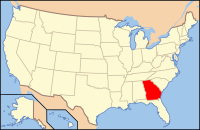Rabun County
| Rabun County, Georgia | |
|---|---|

Rabun County courthouse in Clayton
|
|
 Location in the U.S. state of Georgia |
|
 Georgia's location in the U.S. |
|
| Founded | 1819 |
| Named for | William Rabun |
| Seat | Clayton |
| Largest city | Clayton |
| Area | |
| • Total | 377 sq mi (976 km2) |
| • Land | 370 sq mi (958 km2) |
| • Water | 6.9 sq mi (18 km2), 1.8% |
| Population | |
| • (2010) | 16,276 |
| • Density | 44/sq mi (17/km²) |
| Congressional district | 9th |
| Time zone | Eastern: UTC-5/-4 |
| Website | www |
Rabun County is the northeasternmost county in the U.S. state of Georgia. As of the 2010 census, the population was 16,276. The county seat is Clayton.
With an average annual rainfall of over 70 inches (1,800 mm), Rabun County has the title of the rainiest county in Georgia and is one of the rainiest counties east of the Cascades.
As early as 1760, explorers came to the area now known as Rabun County. In the 18th century, the population of Cherokee in the area was so heavy that this portion of the Appalachian Mountains was sometimes called the "Cherokee Mountains." The early explorers and settlers divided the Cherokee people into three divisions depending on location and dialect, the Lower, Middle, and Over-the-Hill. There were at least four Cherokee settlements in what would later become Rabun County. A Middle settlement called Stikayi (Stiyaki, Sticoa, Stekoa) was located on Stekoa Creek, probably southeast of the present-day Clayton. An Over-the-Hill settlement called Tallulah was located on the upper portion of the Tallulah River. There were also two Cherokee settlements of unknown division, Chicherohe (Chechero), which was destroyed during the American Revolutionary War, located along Warwoman Creek, east of Clayton, and Eastertoy (Eastatowth, Estatowee) which was located near the present-day Dillard.
Despite the prominence of the Cherokee, there is evidence that other Native Americans were in the region before them. A mound similar to others across North Georgia (including the famous Etowah Indian Mounds) is located about one mile (1.6 km) east of Dillard, Georgia and is likely a remnant of an earlier mound-building Native American culture known as the Mississippian culture. The mound location is listed on the National Register of Historical Places as the Hoojah Branch Site.
...
Wikipedia
